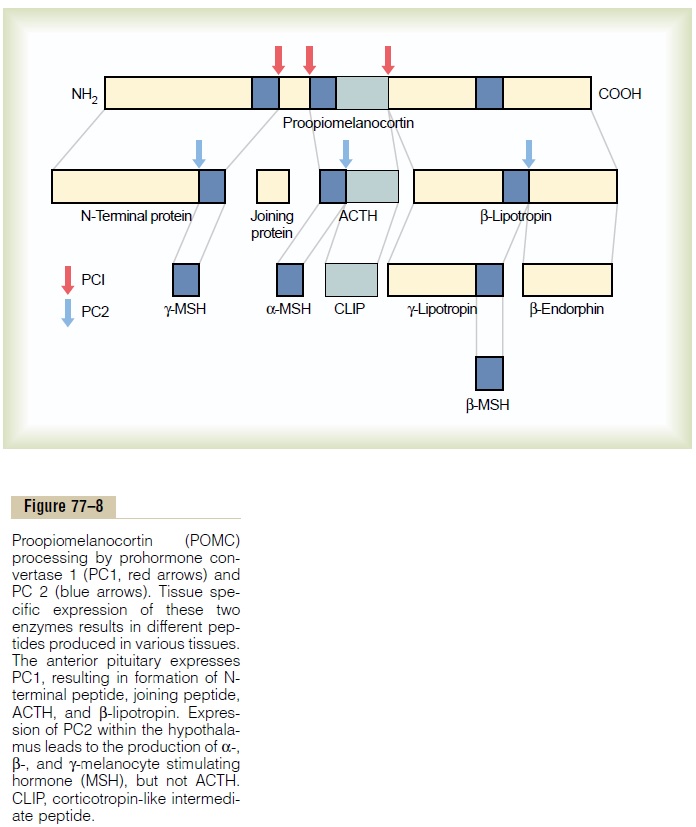Chapter: Medical Physiology: Adrenocortical Hormones
Hyperadrenalism-CushingŌĆÖs Syndrome
Hyperadrenalism-CushingŌĆÖs Syndrome
Hypersecretion by the adrenal cortex causes a complex cascade of hormone effects called CushingŌĆÖs syndrome. Most of the abnormalities of CushingŌĆÖs syndrome are ascribable to abnormal amounts of cortisol, but excess secretion of androgens may also cause important effects. Hypercortisolism can occur from multiple causes, including (1) adenomas of the anterior pituitary that secrete large amounts of ACTH, which then causes adrenal hyperplasia and excess cortisol secretion; (2) abnormal function of the hypothalamus that causes high levels of corticotropin-releasing hormone (CRH), which stimulates excess ACTH release; (3) ŌĆ£ectopic secretionŌĆØ of ACTH by a tumor elsewhere in the body, such as an abdominal carcinoma; and (4) adenomas of the adrenal cortex. When CushingŌĆÖs syndrome is sec-ondary to excess secretion of ACTH by the anterior pituitary, this is referred to as CushingŌĆÖs disease.
Excess ACTH secretion is the most common cause of CushingŌĆÖs syndrome and is characterized by high plasma levels of ACTH as well as cortisol. Primary overpro-duction of cortisol by the adrenal glands accounts for about 20 to 25 per cent of clinical cases of CushingŌĆÖs syn-drome and is usually associated with reduced ACTH levels due to cortisol feedback inhibition of ACTH secretion by the anterior pituitary gland.
Administration of large doses of dexamethasone, a synthetic glucocorticoid, can be used to distinguish between ACTH-dependent andACTH-independentCushingŌĆÖs syndrome. In patients who have overproduc-tion of ACTH due to an ACTH-secreting pituitary adenoma or to hypothalamic-pituitary dysfunction, even large doses of dexamethasone usually do not suppress ACTH secretion. In contrast, patients with primary adrenal overproduction of cortisol (ACTH-independent) usually have low or undetectable levels of ACTH. The dexamethasone test, although widely used, can sometimes give an incorrect diagnosis, because some ACTH-secreting pituitary tumors respond to dexamethasone with suppressed ACTH secretion. Therefore, it is usually considered to be a first step in the differential diagnosis of CushingŌĆÖs syndrome.
CushingŌĆÖs syndrome can also occur when large amounts of glucocorticoids are administered over pro-longed periods for therapeutic purposes. For example, patients with chronic inflammation associated with dis-eases such as rheumatoid arthritis are often treated with glucocorticoids and may develop some of the clinical symptoms of CushingŌĆÖs syndrome.
A special characteristic of CushingŌĆÖs syndrome is mobilization of fat from the lower part of the body, with concomitant extra deposition of fat in the thoracic and upper abdominal regions, giving rise to a buffalo torso. The excess secretion of steroids also leads to an ede-matous appearance of the face, and the androgenic potency of some of the hormones sometimes causes acne and hirsutism (excess growth of facial hair). The appearance of the face is frequently described as a ŌĆ£moon face,ŌĆØ as demonstrated in the untreated patient with CushingŌĆÖs syndrome to the left in Figure 77ŌĆō8. About 80 per cent of patients have hypertension, pre-sumably because of the slight mineralocorticoid effects of cortisol.

Effects on Carbohydrate and Protein Metabolism. The abun-dance of cortisol secreted in CushingŌĆÖs syndrome can cause increased blood glucose concentration, some-times to values as high as 200 mg/dl after meals-as much as twice normal. This results mainly from enhanced glu-coneogenesis and decreased glucose utilization by the tissues.
The effects of glucocorticoids on protein catabolism are often profound in CushingŌĆÖs syndrome, causing greatly decreased tissue proteins almost everywhere in the body with the exception of the liver; the plasma pro-teins also remain unaffected. The loss of protein from the muscles in particular causes severe weakness. The loss of protein synthesis in the lymphoid tissues leads to a suppressed immune system, so that many of these patients die of infections. Even the protein collagen fibers in the subcutaneous tissue are diminished so that the subcutaneous tissues tear easily, resulting in devel-opment of large purplish striae where they have torn apart. In addition, severely diminished protein deposi-tion in the bones often causes severe osteoporosis with consequent weakness of the bones.
Treatment of CushingŌĆÖs Syndrome. Treatment of CushingŌĆÖssyndrome consists of removing an adrenal tumor if this is the cause or decreasing the secretion of ACTH, if this is possible. Hypertrophied pituitary glands or even small tumors in the pituitary that oversecrete ACTH can sometimes be surgically removed or destroyed by radiation. Drugs that block steroidogenesis, such asmetyrapone, ketoconazole, and aminoglutethimide, orthat inhibit ACTH secretion, such as serotonin antago-nists and GABA-transaminase inhibitors, can also beused when surgery is not feasible. If ACTH secretion cannot easily be decreased, the only satisfactory treat-ment is usually bilateral partial (or even total) adrena-lectomy, followed by administration of adrenal steroids to make up for any insufficiency that develops.
Related Topics